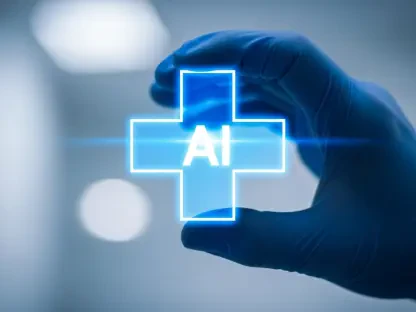Unveiling a Healthcare Revolution: The AI Diagnostics Surge
Imagine a world where a single algorithm can detect a life-threatening disease before symptoms even appear, saving countless lives with pinpoint accuracy. This is no longer a distant dream but a rapidly unfolding reality in the medical diagnostics landscape, driven by artificial intelligence (AI). With the global AI in medical diagnostics market projected to grow at a staggering compound annual growth rate (CAGR) of 22% through 2030, the healthcare sector stands on the brink of transformation. This analysis explores the forces propelling this explosive growth, the trends shaping adoption, and the implications for stakeholders across the industry.
The significance of this market surge extends beyond numbers—it signals a fundamental shift in how diseases are identified and managed. As healthcare systems worldwide grapple with rising patient volumes and limited resources, AI emerges as a critical tool to enhance efficiency and accuracy. This examination aims to provide a clear, data-driven perspective on current market dynamics and future potential, offering actionable insights for healthcare providers, technology developers, and policymakers navigating this evolving terrain.
Market Dynamics: Forces Fueling AI Adoption in Diagnostics
Big Data as the Catalyst for Diagnostic Precision
At the heart of the AI diagnostics boom lies the unprecedented explosion of medical data. Hospitals and clinics generate terabytes of information daily through imaging scans, electronic health records (EHRs), and genomic profiles. Manually sifting through this data is a daunting task, often leading to delays or errors in diagnosis. AI algorithms, powered by machine learning, excel in processing these vast datasets, identifying subtle patterns that might elude human observation, such as early signs of cancer in radiology images.
This capability translates into tangible benefits—quicker turnaround times for results and a reduction in misdiagnoses. For instance, AI systems have demonstrated superior performance in detecting abnormalities in chest X-rays, often surpassing radiologists in controlled environments. However, challenges like data privacy and the need for unbiased training datasets remain hurdles to seamless adoption, pushing the industry to prioritize robust security measures and ethical standards.
Tackling Chronic Disease Burdens and Staff Shortages
The rising prevalence of chronic conditions like diabetes and heart disease is placing immense pressure on diagnostic capabilities globally. AI offers a lifeline by enabling early detection through predictive analytics, such as identifying diabetic retinopathy in eye scans long before patients notice vision changes. This not only improves patient outcomes but also alleviates strain on overworked healthcare systems.
Simultaneously, a persistent shortage of trained medical professionals amplifies the need for automation. AI tools can handle routine tasks like triaging imaging studies, freeing up specialists to focus on complex cases. While this presents an opportunity to optimize workflows, resistance from clinicians wary of technology overstepping human judgment underscores the importance of integrating AI as a supportive, rather than replacement, mechanism in clinical settings.
Regional Variations and Regulatory Landscapes
Geographic disparities play a significant role in the pace of AI adoption within diagnostics. North America dominates the market, bolstered by cutting-edge infrastructure and substantial investments in AI research. Meanwhile, the Asia Pacific region is emerging as a hotspot for rapid growth, fueled by digitization efforts and increasing disease incidence in densely populated countries like China and India.
Regulatory frameworks also shape market trajectories, with varying approval processes and standards across regions. In some areas, stringent policies slow down the deployment of AI tools, while others offer fast-track pathways to encourage innovation. Addressing these inconsistencies through harmonized guidelines and fostering trust in AI systems via transparency will be crucial to unlocking global potential in this sector.
Emerging Trends: Innovations Defining the Future
Strategic Alliances Driving Technological Advancements
A defining trend in the AI diagnostics market is the surge of collaborations between technology giants and healthcare institutions. These partnerships merge clinical expertise with technical prowess, accelerating the development of reliable diagnostic tools. Recent multimillion-dollar agreements, such as those involving major imaging technology advancements, highlight how such alliances ensure solutions are both innovative and practical for real-world application.
These collaborations also facilitate access to diverse datasets, enhancing algorithm accuracy and relevance. As a result, the market witnesses faster integration of AI into everyday clinical workflows, setting the stage for widespread scalability. The emphasis on joint efforts signals a maturing industry focused on bridging gaps between innovation and implementation.
Competitive Landscape and Startup Innovation
The competitive arena in AI diagnostics is vibrant, with established players like Microsoft and Nvidia vying alongside agile startups such as Digital Diagnostics. This mix fosters a dynamic ecosystem where continuous product development and geographic expansion are key strategies. Startups often bring niche, specialized solutions to the table, while larger corporations leverage their resources for broader market penetration.
Venture capital interest further fuels this competitiveness, with significant funding flowing into promising AI diagnostic ventures. This financial backing supports research into next-generation technologies like edge computing, which enables diagnostics in remote areas with limited connectivity. Keeping pace with these rapid advancements requires adaptability and a keen focus on user-centric design from all market participants.
Technological Horizons: Beyond Current Capabilities
Looking toward the future, advancements in deep learning and integration with wearable devices are poised to redefine diagnostics. Enhanced algorithms promise even greater precision in detecting complex conditions, while wearable tech could enable continuous health monitoring outside traditional medical settings. Such innovations hint at a shift toward personalized, real-time healthcare solutions.
Economic factors, including increased government funding and streamlined regulatory approvals, are likely to bolster these developments. However, ethical concerns around data usage and potential biases in AI models will demand vigilant oversight. Balancing technological progress with accountability remains a pivotal challenge as the market evolves through 2030.
Market Projections: Data Insights and Growth Forecasts
Segment-Wise Growth and Application Focus
Breaking down the market by components, software continues to lead due to its central role in powering AI algorithms for diagnostics. Hardware and services also see steady demand as infrastructure needs grow. In terms of modalities, imaging technologies like CT and MRI dominate, reflecting AI’s strength in analyzing visual medical data across specialties such as radiology and oncology.
Applications span a wide range, from cardiology to neurology, with each field benefiting from tailored AI solutions. Hospitals remain the primary end users, driven by high patient throughput and resource availability, though diagnostic centers are catching up as AI becomes more accessible. These segment-specific insights highlight the technology’s versatility and broad impact on healthcare delivery.
Geographic Forecasts: Leaders and Rising Stars
From a regional perspective, North America holds the largest market share, supported by advanced healthcare systems and favorable policies. Projections indicate sustained leadership, with steady growth expected over the next five years. Conversely, Asia Pacific is forecasted to experience the highest CAGR, propelled by rapid healthcare modernization and rising investments in countries with expanding populations.
Latin America and the Middle East & Africa, while currently smaller markets, show potential for growth as digital infrastructure improves. Tailoring AI solutions to local healthcare challenges, such as access in rural areas, will be essential for penetration in these regions. These forecasts underscore the importance of customized strategies to maximize global reach and impact.
Reflecting on the Journey: Strategic Takeaways for Stakeholders
Looking back, the analysis of the AI in medical diagnostics market reveals a sector propelled forward by big data, chronic disease challenges, and innovative partnerships, achieving a projected 22% CAGR through 2030. The examination highlights how regional differences and technological advancements have shaped adoption patterns, with North America leading and Asia Pacific accelerating rapidly. Competitive dynamics and emerging trends underscore a landscape ripe with opportunity yet tempered by ethical and regulatory considerations.
For stakeholders, the path ahead involves prioritizing strategic collaborations to blend technical and clinical expertise, ensuring solutions are both cutting-edge and practical. Investing in clinician education proves vital to overcoming resistance, while robust data security measures address privacy concerns. Focusing on scalable tools tailored to regional needs offers a way to tap into high-growth markets, driving equitable access to diagnostic advancements.
As a next step, industry players are encouraged to pilot AI implementations in diverse settings to validate effectiveness, while advocating for global regulatory alignment to streamline adoption. Leveraging government incentives for technology integration provides a financial boost to these efforts. Ultimately, the focus must remain on patient-centered innovation, ensuring that AI diagnostics not only transforms healthcare but does so with fairness and precision at its core.









